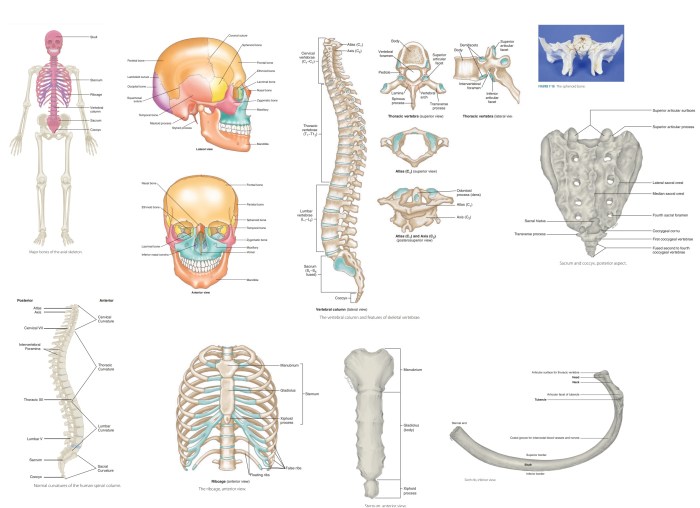Review sheet 8 the axial skeleton – Review sheet 8, a comprehensive guide to the axial skeleton, embarks on an illuminating journey into the human body’s central structural framework. Delving into the intricate anatomy of the vertebral column, skull, and thoracic cage, this exploration unravels their profound roles in supporting, protecting, and facilitating movement within the human form.
As we delve deeper into the axial skeleton’s intricate tapestry, we uncover the remarkable adaptations that enable it to withstand the demands of daily life. From the vertebrae’s shock-absorbing intervertebral discs to the skull’s protective bony landmarks, each component plays a vital role in safeguarding delicate tissues and ensuring seamless bodily functions.
1. Anatomical Overview of the Axial Skeleton
The axial skeleton, the central axis of the body, provides structural support, protection, and mobility. It consists of the skull, vertebral column, and thoracic cage, each with unique components and functions.
The skull, composed of the cranium and facial bones, protects the brain and sensory organs. The vertebral column, made up of vertebrae, intervertebral discs, and the spinal cord, supports the body, protects the spinal cord, and allows movement. The thoracic cage, formed by the ribs, sternum, and costal cartilages, encloses and protects vital organs like the heart and lungs.
2. Vertebral Column
Structure and Function
Structure of the Vertebral Column
The vertebral column, also known as the spine, consists of 33 vertebrae stacked one upon another. Each vertebra comprises a vertebral body, vertebral arch, and various processes for muscle attachment.
Intervertebral discs, located between adjacent vertebrae, act as shock absorbers and provide flexibility. The spinal cord, a bundle of nerves, runs through the vertebral canal formed by the vertebral arches, carrying messages between the brain and the rest of the body.
Functions of the Vertebral Column
The vertebral column provides structural support for the body, allowing it to stand upright and bear weight. It protects the delicate spinal cord from injury and facilitates movement by providing a flexible axis for bending, twisting, and turning.
3. Skull
Anatomy and Bony Landmarks
Anatomy of the Skull
The skull, divided into the cranium and facial bones, encloses and protects the brain and sensory organs. The cranium, the upper portion, is composed of eight bones that form a protective vault for the brain.
The facial bones, located anteriorly, provide structural support for the face and house the sensory organs.
Major Bony Landmarks of the Skull
Key bony landmarks of the skull include the orbits, which house the eyes; the nasal cavity, which allows for respiration and olfaction; and various foramina, which allow for the passage of nerves and blood vessels.
4. Thoracic Cage
Structure and Protection
Structure of the Thoracic Cage, Review sheet 8 the axial skeleton
The thoracic cage, also known as the rib cage, is a protective enclosure for vital organs. It consists of 12 pairs of ribs, the sternum (breastbone), and costal cartilages that connect the ribs to the sternum.
The ribs are curved bones that articulate with the vertebrae posteriorly and the sternum anteriorly. The sternum is a flat bone located in the midline of the chest.
Role of the Thoracic Cage in Protection
The thoracic cage provides a strong and flexible enclosure that protects the heart, lungs, and other vital organs from external forces. It also assists in respiration by expanding and contracting to facilitate the movement of air in and out of the lungs.
5. Comparison of Axial Skeletal Structures: Review Sheet 8 The Axial Skeleton
The vertebral column, skull, and thoracic cage share similarities in providing structural support and protection. However, each has distinct anatomical features and functions.
- Vertebral Column:Provides flexibility, supports the body, and protects the spinal cord.
- Skull:Encloses and protects the brain and sensory organs.
- Thoracic Cage:Protects vital organs, assists in respiration, and provides structural support.
6. Clinical Significance of the Axial Skeleton

Understanding the axial skeleton is crucial in medical diagnosis and treatment. Common injuries and disorders associated with the axial skeleton include:
- Vertebral Fractures:Breaks in the vertebral bodies, often caused by trauma or osteoporosis.
- Vertebral Dislocations:Displacement of vertebrae from their normal alignment, which can damage the spinal cord.
- Spinal Cord Injuries:Damage to the spinal cord due to trauma, infection, or tumors, leading to loss of sensation or movement.
Top FAQs
What is the primary function of the axial skeleton?
The axial skeleton provides structural support, protects vital organs, and facilitates movement.
How many vertebrae are there in the human axial skeleton?
There are 33 vertebrae in the human axial skeleton, divided into five regions: cervical, thoracic, lumbar, sacral, and coccygeal.
What is the significance of the intervertebral discs?
Intervertebral discs act as shock absorbers, cushioning the vertebrae and providing flexibility to the spinal column.